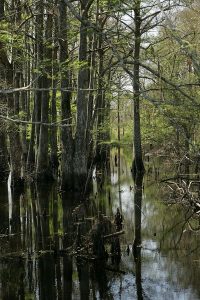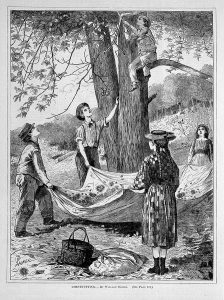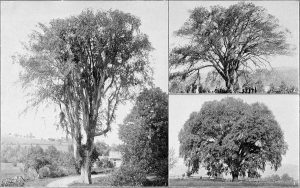
Virginia's Forests: A History
With its expansive mountains, coastal marshes, and many lakes and rivers, Virginia is a heavily forested state. It has numerous state forests and natural areas, such as Stafford County’s Crow’s Nest, that are protected by specific counties. If you go out on a nature hike, fishing trip, or sightseeing for a vacation, you’ll find yourself surrounded by a great number and variety of tree. Trees provide shade for humans, habitat for animals, and help cool the climate. This guide will explain to you the history of trees in Virginia, some of the most common types you’ll find today, and a couple of trees that used to be common that vanished from much of the landscape in the 20th century.
Virginia’s Trees in the Age of Dinosaurs
During the Mesozoic Era, the Age of Dinosaurs, most of the trees now common in Virginia did not yet exist. Flowering plants (which include oak trees) had not yet evolved, and, in the Triassic and Jurassic eras, much of the flora consisted of cycads. These ancient trees differ greatly from Virginia’s current forests. They are gymnosperms (naked seed plants) that tend to rely on very specialized insect pollinators for their seeds, which they bear in cones. Cycads are sometimes called “Sago palm” because their leaves resemble those of palm trees, but they are not true palm trees; an actual palm tree is an angiosperm (flowering plant). Cycads only begun to decline by the middle of the Cretaceous period, to the point in our time when there are no native cycads left in Virginia. Though the cycads are gone from Virginia’s forests, you can still find them wild in places closer to the equator, such as Central and South America and the state of Florida.
Life from a Cone: Virginia’s Conifers
Some gymnosperms continue to survive and be a vital part of Virginia’s ecosystems to this day. The most numerous of these are Virginia’s pine trees, of which there are several species that exist in different parts of the state. Pine trees are evergreen, which means they do not lose their needle-shaped leaves as the fall season begins and can keep their foliage for years if undisturbed. Pines always hold their seeds in cones, which typically open and release small, winged seeds that are moved by the wind. Pines can grow to be quite old, and many species can easily live over 100 years.
Pines in the Blue Ridge and Appalachian Mountains
Pines are particularly common in the Blue Ridge and Appalachian mountains, where you can find large forests of eastern white pine. This is the tallest native pine in our state and naturally occurs in the Fredericksburg area. The Virginia pine or “scrub pine” can also be found in the Fredericksburg area. Unlike the white pine, the Virginia pine was not used much in the lumber industry, although it may be used as a Christmas tree. It can grow in a wide variety of soils and habitats, exists across the state, and is smaller and shorter lived than the white pine. The loblolly pine is considered a southern yellow pine and produces wood that is valuable for home construction and wooden roller coasters. In the early 20th century, Spotsylvania’s loblolly forests covered much of the county, and the timber industry provided for many families. The pond pine can’t be found in Fredericksburg but does appear in the extreme southeast of the state, particularly in the Great Dismal Swamp near Norfolk. This pine is noted for its crooked trunk and the long period between when its cones fall and when they open for fertilization (up to 2 years).
Non-Pine Conifers
There are also several types of non-pine conifers that can be found in Virginia. The bald cypress is a rare deciduous conifer; it sheds its needles in winter, which is why the early settlers called it “bald.” This tree can also be distinguished by the knobby “knees” its roots form that rise out of the watery swamps in which it grows and its long branches covered in Spanish moss. In Virginia, it only grows in the Great Dismal Swamp. The Canada yew is much more common in areas north of Virginia but occurs in the Appalachians in some remnant populations. It is a short shrub that is quite toxic, although some of the toxins it generates are now used in cancer research. Unlike other conifers, it holds its seed cones in a bright red berry-like structure called an “aril,” and the seeds are distributed by birds that eat the aril. In the southwestern corner of Virginia at Mount Rogers, you can find the Fraser fir. It is a relatively short (typically about 50 feet high) tree that is typically grown as a Christmas tree and is noted for its pleasant scent and purple cones. Its wild populations in Virginia and North Carolina have become endangered due to the balsam wooly adelgid, which attacks mature fir trees and made it much more difficult for the wild trees to distribute seeds.
The Old Oaks and Other Flowering Trees
Beyond the conifers listed, Virginia’s landscape is dominated by angiosperms (flowering plants). Angiosperms don’t hold their seeds in cones; instead, they use fruit to attract animals to distribute the seeds for them. They generate the fruit from flowers, which produce pollen that allows the seeds to become fertilized. Before farming and logging changed Virginia’s landscape, Virginia’s forests were dominated by tall, old angiosperm trees such as oak, maple, and ash.
The Crow's Nest: An Old Growth Forest
One of the last places you can see such a forest intact on the East Coast is Crow’s Nest, a large (2,200 acre) area in Stafford that was never cleared or farmed and has trees from two rare forest types. As Crow’s Nest is considered an old growth forest (the end stage of what many wooded areas in Virginia would look like without human intervention), it allows us to look at the types of flowering trees that occur in Virginia.
Hardwood Swamp Trees
The part of Crow’s Nest closest to the water is classified as a tidal hardwood swamp, a habitat that exists along the eastern rivers of Virginia. An important tree in this habitat is green ash, a medium-sized shade tree that provides nesting sites for birds and also provides food for ducks with its seeds. Keeping a healthy population of wild ash trees is very important because these trees are threatened by the emerald ash borer, a beetle that has killed millions of ash trees across the United States. Another tree common in the swamp is red maple, a tree noted for the fact that its leaves always turn red as fall approaches. Old red maples can be quite tall, sometimes growing over 100 feet tall. Its large size makes it an excellent shade tree, and its leaves provide food for rabbits and deer, although they are toxic to horses. Swamp chestnut oak, a flood-resistant tree, is well-adapted for these wetlands. This tree has dark green leaves and very large acorns that are a favorite food of deer. It is sometimes called “basket oak” because people wove strong baskets from its fibers without splitting the wood.
Eastern Harwood Swamp Trees
The southern tip of Crow’s Nest is an even rarer ecosystem called a coastal plain dry calcareous forest. These are typically south-facing slopes on land close to rivers that have their own distinct tree communities due to soil types and the shape of the terrain. One tree that commonly grows on them is chinquapin oak, a large tree of the white oak group. Its leaves have a “saw tooth” shape that resemble those of chestnut leaves. The chinquapin’s acorns are the sweetest tasting of all oak acorns and are widely eaten by wild animals and humans. You can also find the largest of eastern hardwood trees, the tulip tree, at Crow’s Nest. This tree can easily grow over 100 feet tall, and very large individuals can grow over 160 feet! As a magnolia tree, it is noted for its striking yellow-orange flowers, as well as the golden yellow color of its fall leaves. The American beech can also be found on the slopes of Crow’s Nest. This tree’s many leaves provide an excellent source of shade. American beech holds its leaves much longer than most deciduous trees; after its leaves turn a coppery shade in the fall, they will hold on the branches for much of the winter.
Gone in a Generation: Vanished Trees of America
The American Chestnut and Chestnut Blights
Sadly, not all trees have been preserved in the present-day landscape of America. Two trees species, in particular, have seen a rapid decline that has made them vanish from the forests and parks of the United States. The first of these trees is the American chestnut, which was considered the finest chestnut tree in the world for hundreds of years. Its natural range consisted of much of northern and western Virginia, and it was a very important source of hardwood timber, especially since its wood was rot resistant. Over four billion American chestnuts existed in the forests of the North American continent. In 1904, tragedy struck as chestnut blight, a disease occurring on Chinese chestnuts, was introduced into North America. The fungus was not particularly dangerous to the Chinese chestnuts but was absolutely lethal to the American chestnuts, destroying the adult trees and eliminating them from their historical range within decades. The American chestnut is now considered functionally extinct; the blight does not kill the roots of the tree, so sprouts may still occur in its historical range, but these die within a few decades as they mature and the blight takes effect. In North Carolina, a hybridization program to create a blight-resistant American chestnut by crossing it with the Chinese chestnut is underway, and a few mature American chestnuts still linger on in isolated groves. Perhaps someday an American chestnut restoration will occur, and we can see forests with these beautiful trees once more.
The American Elm
Another once-common tree that rapidly declined over the 20th century is the American elm. Its natural range consisted of much of the eastern United States and Canada, and it was considered so beautiful that many American parks and streets consisted only of elm trees. The tree became far more numerous in cultivated lands than it would have been in a natural landscape.
Dutch Elm Disease
This elm monoculture was vulnerable once Dutch elm disease (DED) was introduced into the United States in the 1930s. A fungal disease spread by beetles, DED killed millions of American elm trees despite the government’s best efforts to contain its spread. Tree planters now discourage the use of one-tree planting in parks and urban planning, allowing for better protection of the remaining old-growth American elms. The American elm survives in more places than the American chestnut because even young trees can produce viable seed, but old growth elms are very rare now outside of isolated groves and wilderness areas where DED is rare. DED-resistant American elms have existed since the late 1990s, and there is hope that these will be able to pass their genes into the young American elms that still occur, allowing some American elms to grow to maturity as they did before the 20th century.
Everchanging Forests of Virginia
There have been many changes to North America’s forests over a very short period of time. Once numerous species, such as the American elm and American chestnut, have all but vanished. Land that was used for farming in the 19th century has become forest once more and is passing through its early growth stages. There are many different kinds of trees in Virginia’s forests, and they play vital roles in our ecosystem, sustaining the lives of animals and humans. As our forests change color during fall, take a look at the trees around you, and see how unique they are!
Online Tree Resources and History
- Which Settled First: The Oak or the Acorn?, opens a new window
- Master Gardeners of Northern Virginia: The Conifer
Books and websites on the types of trees you can find in Virginia and other Eastern/Southern states.








